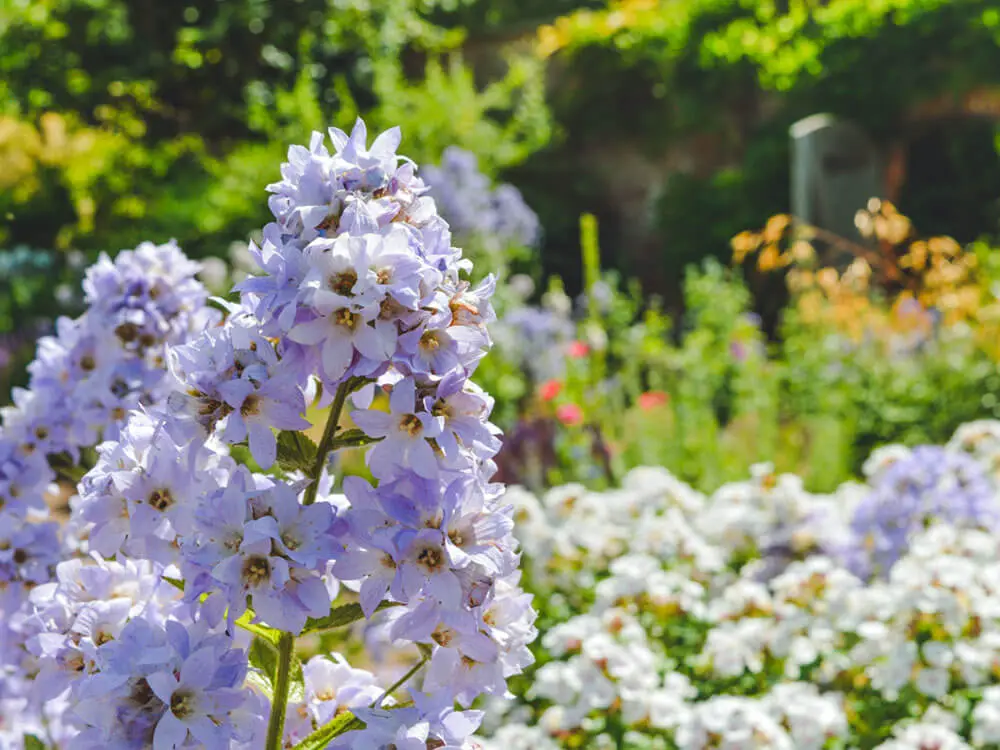14 Traditional Cottage Garden Flowers and Herbs
October, 2022 |While some garden styles focus on geometric designs, clean lines, and conformity, the cottage garden instead encompasses a charming, informal, and folksy style. Traditional cottage garden flowers create this informal look as they effortlessly blend into a Monet-style painting, speckled with soft hues, undulating heights, and frothy flower clusters.
The cottage garden look is a timeless garden style design. Its signature characteristics are usually described as natural and romantic, with soft textures, and overflowing borders.
What defines a cottage garden flower?
Traditional cottage garden flowers include a mix of annuals, biennials, and perennials. Climbing, shrubby or herbaceous plants. All in a mix of shades and hues. So what links them together?
Typically they are usually summer flowering plants, but it’s history and culture that officially categorize cottage garden plants as one.

Today, most of us grow cottage garden flowers simply for their old-fashioned heritage and beauty. However, the cottage garden was initially a place for people to grow food and valuable herbs used in their homeopathic recipes.
Some were exotic imports from the 1600s that became timeless classics (sweet peas), and others were native wildflowers that were welcomed into the garden (foxglove). Many had significant meaning in Victorian floriography too and were used as cut flowers or gifts.
The most traditional cottage garden flowers and herbs
If you’re planning on creating your own cottage garden, here’s a list of 14 of the most traditional cottage garden flowers (each approved by a British Grandma!).
For each cottage garden flower, we mention if they’re annual, biennial, or perennial and provide a few general care tips so you can keep them in tip-top shape. We’ve also listed their Victorian floriography meaning too.
1. Hollyhocks (Althaea)
One of the most signature cottage garden plants. Walk along a row of houses in the Cotswolds in England during the summer and you’ll see tall spires of hollyhock flowers bobbing above the limestone walls of cottage gardens.
Care and planting tips:
Hollyhocks can be annual, biennial, and even perennial, but most are grown as biennial plants. Collect their seeds in late summer/autumn and you can easily grow your own!
In the Victorian era, Hollyhocks were seen as a symbol of fecundity and ambition, particularly for females.

2. English Lavender (Lavandula)
A traditional cottage garden would be incomplete without lavender billowing out of borders or containers. You can find lots of varieties in shades of blue, pink, and purple.
Lavender is well known for its calming scent, so it’s a great addition to any garden. Lavender was a popular homeopathic herb too and was used in recipes to soothe headaches and stiff joints. Another common use was to add dried lavender flowers to small bags and place them inside wardrobes and drawers as a moth deterrent.
Care and planting tips:
English lavender is a hardy perennial shrub, so once planted it will come back year after year with a little care and maintenance. Prune back dead flower stems in late summer to keep the plant looking bushy.
Lavender was seen as a symbol of distrust in Victorian floriography.

3. Delphinium
Another tall cottage garden plant that has to be included, delphiniums are usually placed at the back of a traditional cottage garden border to add height and color. The most popular delphinium shades are cobalt blue and purple.
Care and planting tips:
You might need to support their tall flower spires with bamboo canes or plant supports. They’re perennial, so will continue to grow for several years. After roughly 4 years, it’s usually recommended to divide the plant in spring, to encourage new growth.
Delphiniums were thought to symbolize a soaring or fanciful imagination, levity, fickleness, and haughtiness.

4. Common Peony (Paeonia officinalis)
Today there are lots of beautiful peony varieties to choose from, but the original cottage garden variety was the common peony (Paeonia officinalis). Their large showy flowers are deep pink and bowl-shaped and have the most amazing fragrance.
Although the flowering period doesn’t last as long as some other cottage garden plants, their huge, fragrant flowers are hard to resist.
Care and planting tips:
Plant them in a sunny location as they need lots of sunlight to flower. They’re perennial, so should return year after year if you look after them.
Peonies were thought to symbolize shyness.

5. Sage (Salvia)
Common sage (Salvia officinalis) was a popular medicinal herb and flower in traditional cottage gardens. It was used in cooking, but also in homeopathic recipes to treat coughs, colds, and even indigestion.
Today there are lots of beautiful salvia cultivars to choose from, including the pink ‘Summer Jewel’ and the striking, bright red ‘Flare’. Salvias are a great option if you’re creating a butterfly-friendly garden too.
Care and planting tips:
Sage is a perennial shrub. To prolong the spires of beautiful flowers, deadhead them after flowering to encourage new blooms. As a plant with Mediterranean roots, make sure it’s in well-drained soil and a sunny position.
Sage is thought to symbolize wisdom, admiration, and respect.

6. Sweet Peas (Lathyrus)
Sweet peas are a cottage garden staple and a classic British favorite that originally came from Sicily in 1699. As a member of the pea family they’re a vining plant, so are traditionally grown and supported with bamboo canes.
As their name suggests, they have an amazingly fragrant and sweet scent, and their long-stemmed flowers make beautiful cut flowers. The seeds are not edible, but can easily be collected for sowing next year’s plants.
Care and planting tips:
Their vines need something to climb, so they’re an ideal flower in a vertical garden. They’re an annual flower, so you’ll need to collect and sow the seeds if you want them to return next year. If you live in USDA zone 7 and above, you can usually sow them in autumn and overwinter them for earlier flowers in spring!
Sweet Peas are thought to symbolize departure.

7. Stocks (Matthiola)
Stocks have been grown in cottage gardens for hundreds of years. They’re a great long-lasting cut flower and are loved for their fragrance. They’re a popular choice for containers or borders near a window so their fragrance drifts in with the breeze.
Care and planting tips:
Available as half-hardy annuals that are sown in the spring for summer flowers, or biennials that are sown in the summer for flowering next spring.
Stocks are thought to symbolize long-lasting beauty and promptness.

8. Foxglove (Digitalis)
Completing the trio of tall cottage garden plants, the foxglove is a popular choice for shady areas. Although toxic, the original woodland plant has its roots in medicinal history.
Today you can buy foxglove varieties in a range of beautiful colors and heights. But the original wildflower was the magenta Digitalis purpurea. Its jewel-like tubular flowers are loved by bees.
Care and planting tips:
They’re usually biennial or perennial, though fairly short-lived. Deadhead after flowering (before the seeds develop) to encourage it to flower again. It will usually set seed itself, but as many are biennial they will flower in the second year.
In floriography, foxgloves usually symbolize insincerity.

9. Old Garden Roses
Another must-have in your cottage garden is the old garden rose (heirloom roses). Old garden roses include any roses that pre-date the modern rose variety “La France” that was cultivated in 1867. Albas, Centifolias, Damasks, Gallicas, and Mosses are all types of summer-flowering old roses.
Popular varieties include the white Madame Hardy rose (Damask from 1832), the pink Amelia rose (Alba from 1823) and the deep crimson Tuscany rose (Gallica from 1600).
Care and planting tips:
As perennial shrubs, they’ll return each year, but for healthy growth and lots of flowers, they’ll need pruning. Make sure the ground is not frozen when planting (either in the ground or containers).
In floriography, roses usually symbolize love and affection, but it depends on the type and color.

10. Violets (Viola)
Loved by Victorians, violas (Johnny Jump Ups) are a sweet, low-growing flower that’s ideal for containers and the front of borders. Wild violas were used in lots of homeopathic recipes, including perfumes, cleansing lotions, and also tea to soothe headaches.
If you only have limited planting space, violas work really well as trailing plants for vertical gardens. There are also some cute dwarfing viola varieties, like Viola x williamsiana ‘Sweeties’. These would also work really well in a mini fairy garden!
Care and planting tips:
Violets are hardy perennials that can flower in winter and spring. You can plant them in moist locations with partial shade.
In floriography, violets were seen as a symbol of modesty.

11. Pinks (Dianthus)
Grown and enjoyed for centuries, Pinks are a popular, sweet-smelling addition to a cottage garden. You can buy them in multiple colors, as the name ‘pinks’ actually comes from their serrated petals which look like they’ve been cut with pinking shears.
Other classic Dianthus cottage garden flowers that you could include are Sweet Williams and Carnations.
Care and planting tips:
Cut back the spent flowers in summer to encourage a second flowering. They’re a short-lived perennial, soon becoming woody and leggy, so to keep them going, propagate cuttings to create new plants.
In floriography, pinks symbolize boldness.

12. Canterbury Bells (Campanula)
Grown in British gardens for hundreds of years, campanula flowers are an often overlooked but classic cottage garden flower. Their tiny bell-shaped flowers attract bees and supposedly their pollen makes a really sweet honey.
Cultivars include a mix of heights and shades, from mat-forming plants to taller spires of flowers, but typically their flowers are always a soft lilac blue, pastel purple, or white. The tiny bells bobbing on thin stems can give your borders and containers a softened, fairy-like elegance.
Care and planting tips:
They can be annual or perennial. Make sure you trim away spent flowers in the summer to encourage them to flower again through late summer/autumn.
In floriography, canterbury bells symbolize acknowledgment.

13. Primrose (Primula)
The common primrose is originally a wildflower (Primula vulgaris), though as it was valued as a medicinal and potherb, it was frequently grown in cottage gardens and seen as a useful flower to have on hand.
There are now lots of different primula varieties to choose from that work well in a cottage garden. Including the pink Primula rosea ‘Grandiflora’ and the purple Japanese primula.
Care and planting tips:
Best planted in partial shade, make sure the soil has plenty of moisture (but it’s not waterlogged). They’re grown as annuals or biennials, but will readily self-seed.
In floriography, the common primrose symbolized youth and sadness.

14. Pot Marigolds (Calendula officinalis)
One of the most traditional cottage garden flowers, pot marigold was a popular medicinal herb in Europe, and it soon became a common cottage garden flower. It was used to create a healing salve to soothe scratches, burns, and spots, and it was even drunk as a floral tea to improve circulation.
They’re really easy to grow, and it was actually a flower that was often used to introduce young children to sowing and gardening.
Other traditional cottage garden flowers in the daisy family that you could include are feverfew, chrysanthemums, oxeye daisy, and the Michaelmas daisy (Aster).
Care and planting tips:
As an annual, you’ll need to resow pot marigolds each year. There are lots of varieties available in different shades and petal formations (Lemon Daisy and Geisha Girl are old-fashion classics), but Calendula officinalis was the original!
In floriography, pot marigolds symbolize grief.

Other popular cottage garden flowers
These flowers also appear on many people’s favorite cottage garden flower lists, and all blend effortlessly into that natural cottage garden style.
- Lobelia
- Cornflowers
- Lupins
- Catmint
- Mignonette
- Hyssop
- Vervain
- Phlox
- Red valerian
- Jacobs ladder
- Lungwort
- Scabious
- Snapdragons

To complete the look, you could combine these typical cottage garden flowers with culinary herbs and heirloom garden vegetables too. You’ll find a list of traditional heirloom vegetables, and herbs, in our guide to creating a cottage garden in containers.





